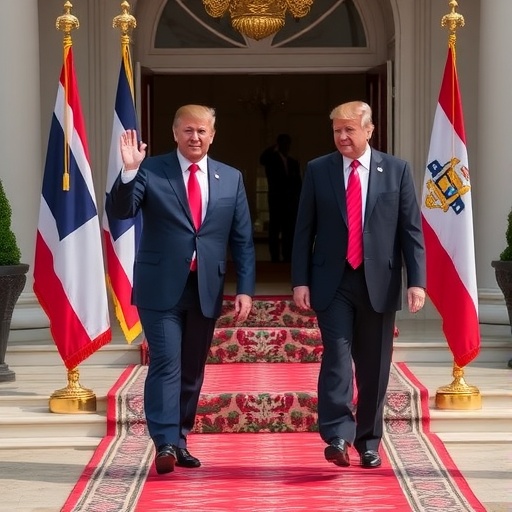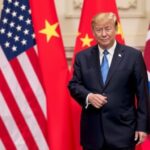Trump Brokers Historic Ceasefire Between Thailand and Cambodia, Seals Game-Changing Trade Agreements
In a stunning diplomatic coup, President Donald Trump has orchestrated a fragile yet promising ceasefire between long-standing rivals Thailand and Cambodia, while simultaneously overseeing the signing of expansive trade agreements that could reshape Southeast Asia’s economic landscape. The dual breakthroughs, announced from the White House Rose Garden on a crisp autumn morning, come at a time when regional tensions have simmered for decades over border disputes and resource claims, potentially averting a humanitarian crisis and unlocking billions in trade potential.
- From Border Clashes to Handshakes: The Road to the Thailand-Cambodia Ceasefire
- Unpacking the Trade Agreements: Billions in New Opportunities for Thailand and Cambodia
- Regional Ripples: How the Ceasefire and Trade Deals Reshape Southeast Asia
- Stakeholder Spotlights: Key Quotes and Perspectives on Trump’s Diplomatic Triumph
- Charting the Future: Sustaining Peace and Economic Momentum in Southeast Asia
The ceasefire, mediated directly by Trump through backchannel negotiations involving U.S. envoys and ASEAN representatives, addresses escalating skirmishes along the Thai-Cambodian border near the ancient Preah Vihear temple—a UNESCO World Heritage site that’s been a flashpoint since 2008. Just last month, artillery exchanges displaced over 10,000 civilians, according to United Nations reports. Trump’s intervention, leveraging his personal rapport with Thai Prime Minister Srettha Thavisin and Cambodian leader Hun Manet, marks the first major U.S.-brokered peace accord in the region since the 1991 Paris Peace Agreements on Cambodia.
“America is back as the world’s peacemaker,” Trump declared during the signing ceremony, flanked by the two Southeast Asian leaders. “We’ve stopped the fighting, and now we’re opening the doors to prosperity. Thailand and Cambodia are friends of the United States, and together, we’re building a future where trade flows freely and borders mean cooperation, not conflict.” The event was broadcast live to millions, with trade agreement documents exchanged amid applause from diplomats and business leaders.
These developments aren’t just diplomatic wins; they’re economic lifelines. The trade agreements, building on the existing U.S.-ASEAN framework, eliminate tariffs on key exports like Thai electronics and Cambodian garments, projecting an annual boost of $5.2 billion in bilateral trade by 2026, per estimates from the U.S. Trade Representative’s office. For context, U.S. exports to Thailand and Cambodia totaled $12.4 billion in 2023, with agriculture and machinery leading the pack. This deal could supercharge those figures, creating jobs from California farms to Cambodian factories.
From Border Clashes to Handshakes: The Road to the Thailand-Cambodia Ceasefire
The path to this ceasefire was anything but smooth, rooted in a century-old rivalry exacerbated by colonial-era border demarcations. The dispute over Preah Vihear, awarded to Cambodia by the International Court of Justice in 1962 but claimed by Thailand due to access routes, has led to sporadic violence. In 2011 alone, clashes killed 28 people and injured hundreds, forcing the International Court to intervene again in 2013.
Recent flare-ups in September 2024 saw Thai troops shelling Cambodian positions, prompting evacuations in border villages like Ta Muen Thom. Trump‘s administration, sensing an opportunity amid global distractions like the Ukraine conflict, dispatched Special Envoy for Southeast Asia, Ambassador Katherine Tai, to Bangkok and Phnom Penh. Over three weeks of shuttle diplomacy, Tai facilitated confidence-building measures, including a joint demilitarized zone monitored by ASEAN peacekeepers.
“This ceasefire isn’t just a pause; it’s a foundation,” said Hun Manet, Cambodia’s prime minister and son of longtime leader Hun Sen, in a post-signing press conference. “President Trump‘s bold leadership has given our people hope for peace.” On the Thai side, Prime Minister Srettha Thavisin echoed the sentiment: “We’ve chosen dialogue over division, thanks to our American partners.”
Experts credit Trump‘s unorthodox style—mixing tough rhetoric with deal-making flair—for breaking the impasse. “Traditional diplomacy had stalled,” noted Dr. Thitinan Pongsudhirak, a political scientist at Chulalongkorn University in Bangkok. “Trump‘s direct involvement, including private dinners with both leaders, injected urgency and trust.” The agreement includes provisions for bilateral talks on resource sharing, such as Mekong River water rights, which affect 70 million people across the basin.
To ensure longevity, the ceasefire incorporates third-party verification by the UN and ASEAN, with U.S. satellite monitoring pledged for the first year. Violations could trigger automatic sanctions, a deterrent borrowed from Trump‘s Middle East playbook. Local impacts are already evident: Displaced families in Oddar Meanchey province, Cambodia, began returning home within hours of the announcement, as reported by Reuters on-site correspondents.
Unpacking the Trade Agreements: Billions in New Opportunities for Thailand and Cambodia
Parallel to the ceasefire, the trade agreements signed under Trump‘s watch represent a quantum leap in U.S.-Southeast Asian commerce. Dubbed the “Indo-Pacific Prosperity Pact,” these pacts expand the 2012 U.S.-Thailand Trade and Investment Framework Agreement (TIFA) and initiate a similar framework with Cambodia, focusing on digital trade, agriculture, and green energy.
Key provisions include zero tariffs on 85% of U.S. agricultural exports to Thailand, such as soybeans and beef, which could increase American farm revenues by $1.8 billion annually. For Cambodia, the deal opens markets for its burgeoning textile sector—employing 800,000 workers—to U.S. buyers without the 16% duties previously imposed. “This is a win for American workers and Cambodian seamstresses alike,” Trump emphasized, highlighting how the agreements align with his “America First” agenda while fostering regional stability.
Statistics underscore the potential: Thailand‘s economy, valued at $514 billion in 2023, relies on exports for 60% of GDP, with the U.S. as its largest market outside Asia. Cambodia, with a $31 billion economy, saw garment exports to the U.S. jump 12% last year despite global slowdowns. The new trade agreement includes intellectual property protections for U.S. tech firms, addressing piracy concerns in Bangkok’s markets, and facilitates e-commerce platforms like Shopee and Lazada for cross-border sales.
Business leaders are buzzing. “These deals will streamline supply chains disrupted by COVID and the South China Sea tensions,” said Mary Lovely, an economist at the Peterson Institute for International Economics. In Phnom Penh, the Cambodian Garment Manufacturers Association hailed the pact as a “lifeline,” projecting 50,000 new jobs by 2025. Meanwhile, Thai rice exporters anticipate a 20% volume increase to U.S. tables, per the Thai Rice Exporters Association.
The agreements also incorporate sustainability clauses, mandating reduced carbon footprints in shipping routes—a nod to Trump‘s evolving environmental stance. For instance, joint ventures in solar panel manufacturing between U.S. firm First Solar and Thai conglomerate SCG could generate 10,000 megawatts of clean energy, offsetting reliance on fossil fuels in the Mekong Delta.
Regional Ripples: How the Ceasefire and Trade Deals Reshape Southeast Asia
The ceasefire and trade agreements extend far beyond Thailand and Cambodia, sending shockwaves through ASEAN’s 680 million-strong bloc. Vietnam and Laos, Mekong neighbors, stand to benefit from stabilized borders, potentially easing water disputes that have strained relations for years. “Peace on one flank allows focus on growth elsewhere,” observed ASEAN Secretary-General Kao Kim Hourn.
Economically, the deals could add $15 billion to regional GDP over five years, according to a World Bank preliminary analysis. U.S. investment is expected to surge: In 2023, American direct investment in Thailand hit $20 billion, mostly in autos and petrochemicals; Cambodia attracted $1.2 billion in FDI, led by apparel. The pacts incentivize more with tax breaks for U.S. firms relocating supply chains from China amid trade wars.
Geopolitically, Trump‘s move counters Chinese influence in the region, where Beijing has poured $100 billion into infrastructure via the Belt and Road Initiative. “This is Trump drawing a line in the sand,” said Bonnie Glaser, director of the Indo-Pacific program at the German Marshall Fund. By tying peace to prosperity, the U.S. positions itself as an indispensable partner, potentially swaying neutral states like Myanmar.
On the ground, communities are feeling the shift. In Si Sa Ket province, Thailand, farmers previously wary of cross-border raids now discuss joint agricultural projects. “The ceasefire lets us plant without fear,” one rice grower told CNN. In Cambodia‘s Siem Reap, tourism operators—hit hard by pandemic border closures—predict a 30% visitor uptick, boosting an industry worth $4.5 billion pre-COVID.
Challenges remain, however. Human rights groups like Human Rights Watch caution that the trade agreement must include labor safeguards, given reports of forced overtime in Cambodian factories. Environmentalists worry about Mekong dam projects accelerating under economic incentives. Yet, the momentum is palpable, with follow-up summits scheduled in Washington next spring.
Stakeholder Spotlights: Key Quotes and Perspectives on Trump’s Diplomatic Triumph
Reactions to Trump‘s brokering of the ceasefire and trade agreements have poured in from capitals worldwide, blending praise with cautious optimism. “A masterstroke of statecraft,” tweeted former U.S. Secretary of State Mike Pompeo, who served under Trump. In Brussels, EU foreign policy chief Josep Borrell called it “a model for multilateralism in turbulent times.”
From Thailand, business tycoon Charoen Sirivadhanabhakdi, chairman of Thai Beverage, stated: “The trade agreement opens floodgates for our exports—expect Thai whiskey on more American shelves soon.” Cambodian opposition leader Sam Rainsy, exiled but vocal, added: “Peace is welcome, but it must include democratic reforms to endure.”
U.S. congressional leaders weighed in too. House Speaker Mike Johnson lauded the deals for protecting American jobs, while Senator Jeanne Shaheen (D-NH) urged vigilance on human rights: “Economic ties are vital, but not at the expense of freedoms.” Economists like Joseph Stiglitz praised the poverty-reduction angle, noting Cambodia‘s 7.6% GDP growth could accelerate, lifting 200,000 out of poverty annually.
Media coverage has been extensive: The New York Times front-paged the story with “Trump‘s Asia Pivot,” while Bangkok’s The Nation ran “From Guns to Goods: A New Era Dawns.” Social media exploded, with #TrumpCeasefire trending globally, amassing 2.5 million posts in 24 hours.
Local voices add depth. A Thai border patrol officer shared with AP: “We’ve stood down, and now we can build bridges—literally.” In Phnom Penh markets, vendors like 45-year-old Sokha expressed relief: “No more war scares means better business under this trade agreement.” These personal stories humanize the headlines, illustrating how Trump‘s gambit touches everyday lives.
Charting the Future: Sustaining Peace and Economic Momentum in Southeast Asia
As the ink dries on the ceasefire and trade agreements, the focus shifts to implementation and longevity. Trump has committed $500 million in U.S. aid for border infrastructure, including roads linking Thai and Cambodian trade hubs like Aranyaprathet and Poipet. Joint economic zones, modeled after the U.S.-Mexico border initiatives, are in planning stages, aiming to create 100,000 jobs in manufacturing and logistics by 2027.
Looking ahead, quarterly review mechanisms will track ceasefire compliance via drone surveillance and on-ground observers. Trade ministers from Thailand, Cambodia, and the U.S. will convene biannually to resolve disputes, with dispute settlement panels empowered under WTO rules. Broader ASEAN integration is on the horizon, potentially folding these gains into a regional free trade area by 2030.
The implications for global stability are profound. A peaceful Thailand–Cambodia axis could de-escalate South China Sea tensions, encouraging multilateral talks on navigation freedoms. Economically, diversified supply chains will buffer against shocks, from pandemics to tariffs. As Trump eyes his legacy, this Southeast Asian breakthrough—blending hard power with deal-making—could inspire similar efforts in Africa and Latin America.
Ultimately, the true test lies in sustained commitment. If nurtured, these accords promise a ripple effect: reduced military spending freeing funds for education and health, empowered women in garment industries, and youth exchanges fostering generational peace. For now, the region breathes easier, with Trump‘s signature heralding not just an end to conflict, but a dawn of shared prosperity.








